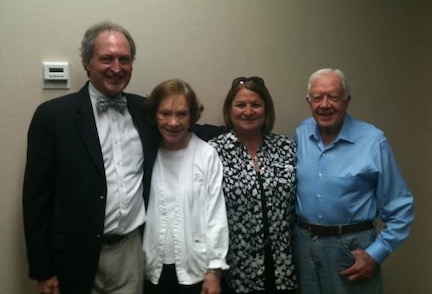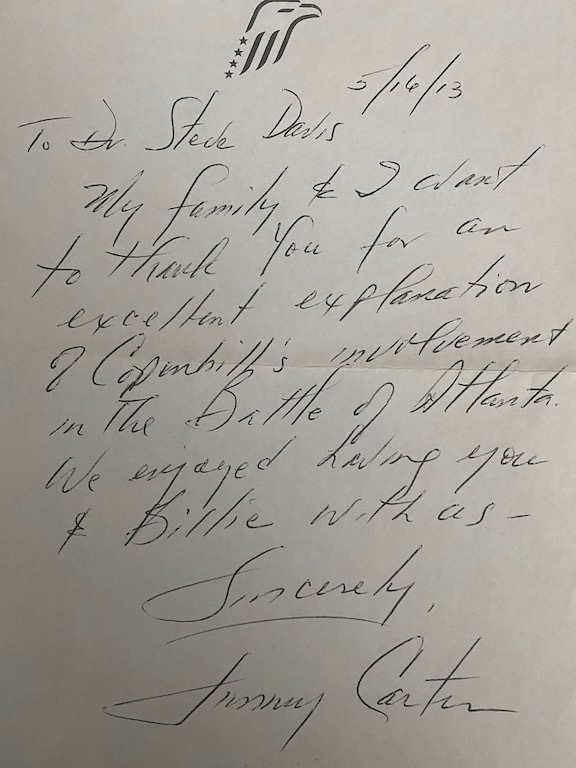My Civil War Evening with Jimmy Carter
 Some years ago, I taught evening courses at Oglethorpe University in northeast Atlanta. One of my students, Lauren Gay, happened to work at the Jimmy Carter Center and Presidential Library. In August 2012 she arranged for me to give a lunch-and-learn to Carter Center staff members on a subject of historical interest. They knew, from historical markers in the area, that the Center was located near the Augustus Hurt house, which in the battle fought east of Atlanta on July 22, 1864 had been Sherman’s headquarters. (It’s shown distantly in the Cyclorama.) But they wanted to know, exactly where?
Some years ago, I taught evening courses at Oglethorpe University in northeast Atlanta. One of my students, Lauren Gay, happened to work at the Jimmy Carter Center and Presidential Library. In August 2012 she arranged for me to give a lunch-and-learn to Carter Center staff members on a subject of historical interest. They knew, from historical markers in the area, that the Center was located near the Augustus Hurt house, which in the battle fought east of Atlanta on July 22, 1864 had been Sherman’s headquarters. (It’s shown distantly in the Cyclorama.) But they wanted to know, exactly where?
I did some research, made a PowerPoint presentation and gave it to several dozen staff members. Afterward, one of them told me that Mrs. Carter was very interested in the matter, and that I could expect a call from her chief of staff. Whoah!
Sure enough I was contacted several months later. Back then—spring 2013—the Carters were driven from Plains and spent one week out of the month at the Center offices and residence. On one night of that week they held a family dinner: Amy, a couple of the sons and loads of grandchildren all lived nearby. It was on a Wednesday in May that I was scheduled to speak during the dinner.
The Secret Service clearance was easy enough, but the research was tougher. Fortunately, decades earlier Wilbur G. Kurtz—the guardian angel of Atlanta’s Civil War history—had researched the history of the area in east Atlanta known as Copenhill. In 1913 he had even corresponded with old man Hurt before he died! Then he fixed the location of the Augustus Hurt house at 176 Cleburne Avenue—yup, named for the General—based on his contact with the then-owner in the 1920s. The site could still be marked on Atlanta city maps in the early ‘70s.
But then Freedom Parkway and the Carter Center obliterated Cleburne Avenue, but not adjoining Cleburne Terrace, which proved the key. Once the staff gave me a map of the expansive grounds, I could fix the Hurt house site. In February 2013 I visited it with staff members: the high ground in the northeast corner of the Center parking lot. So I added some slides, practiced my talk and waited for the appointed day.
My wife Billie and I made sure to show up early…in fact so early we saw Mrs. Carter in keds and with plastic sword, participating in her Tai Chi class!
Then we were led to the main office, which was already filling with staff and family members. The President, in jeans, greeted me warmly. He pointed to his big picture window and said he was used to telling visitors that Sherman’s headquarters had been in the distance outside. The window faced south; I knew this was the wrong direction. So summoning all the tact I could in addressing the former leader of the free world, I simply said, “Mr. President, you may have to reorient your perspective.”
I then led the President out through the parking lot; Billie walked behind us with Rosalynn, followed by staff and family. Secret Service halted motorists away from our entourage; they snapped pictures on their phones while Jimmy smiled and waved pleasantly.
We returned to the main office building and went downstairs. In a big room, the barbecue buffet was laid out with a lot of round dining tables. Amy pulled my wife aside: “Billie, Steve should be proud. Usually at our family dinners we have a dozen or so, but tonight we’ve got more than two dozen!” Jason Carter, then a state senator, even brought his two young sons.
Jimmy Carter had been President, of course, but at the age of 88, he was still paterfamilias. So it took him only one clap of his hand to get everyone’s attention, say grace, and direct all through the line. Once everyone was served and seated, he announced that Dr. Davis would begin his presentation.
Billie and I did not take a plate. She sat in the back of the room with a Secret Service lady while I fussed with my PowerPoint. My wife noticed that along with the ‘cue, red wine was being served—but from 1.5-liter magnums, of the Kroger variety.
When called upon I began my talk—rather briskly, mind you, as I was a little nervous. Jimmy and Rosalynn, though, put everyone at ease. I was impressed by the President at one point inserting that the Federals’ twisted rails had been called “Sherman’s neckties.” At another point, when I said that as Sherman was fixin’ to march to the sea, Rosalynn broke into gleeful laughter. “Steve, in the old days when we held social functions, I would walk about, listening for the word fixin’—when I heard it, I knew I could talk with a true Southerner.”
I tarried on my slide showing the grounds and the presumed Hurt house site. After I had finished, the President thanked me for teaching him things he hadn’t known.
We began to say our goodbyes. When again I thanked the President he called for someone to take our picture (attached).
Feeling our work done, Billie and I headed for the door. A Secret Service agent, though, motioned us away. “Officer,” I said, “we have been vetted,” but he pointed us to Amy, who approached my wife. “Billie, I’m always getting in trouble with Daddy! Please help me! He says I can’t let you leave till I fix you and Steve two plates of barbecue!” Dutifully, we got our plates, brandished them to the Secret Service man, and were finally permitted to leave.
Two days later, I received a handwritten note of thanks from the President .
.
So that was my evening with Jimmy Carter. You don’t forget that kind of stuff.
How neat! What a great memory!
Sounded interesting. Any chance that you could produce an Hurt House article that could enlighten the rest of us?
I second that request!
Sure Scott–tell me more!
Hey Vic–an article for a pub? Sure–tell me more!
Steve – I’m sure you could cobble something together from your notes/background research that would make a great article:
Here is a hodge-podge of ideas –
– a summary of the Hurt House pre-CW, some Hurt family background
– role of the house and general area during the battle
– CW characters (notable/civilian) who were present during the period – interesting people/soldier stories from those who were there
– notable events from the battle, significance of why was it included in the Cyclorama painting.
– sketches/photo’s pre/during/post battle
– photo’s pre-destruction
– an orientation to where the house once stood – with a photo (perhaps either a map or satellite view of where the location would be today)
– you can even use the word fixin’ 🙂
Like I said, the above is a hodge-podge, I’m sure you have lots of research details just waiting to be written.
Thanks for asking!
What a great story! A memory to cherish forever.
Thank you, Scott–I’ll never forget it!